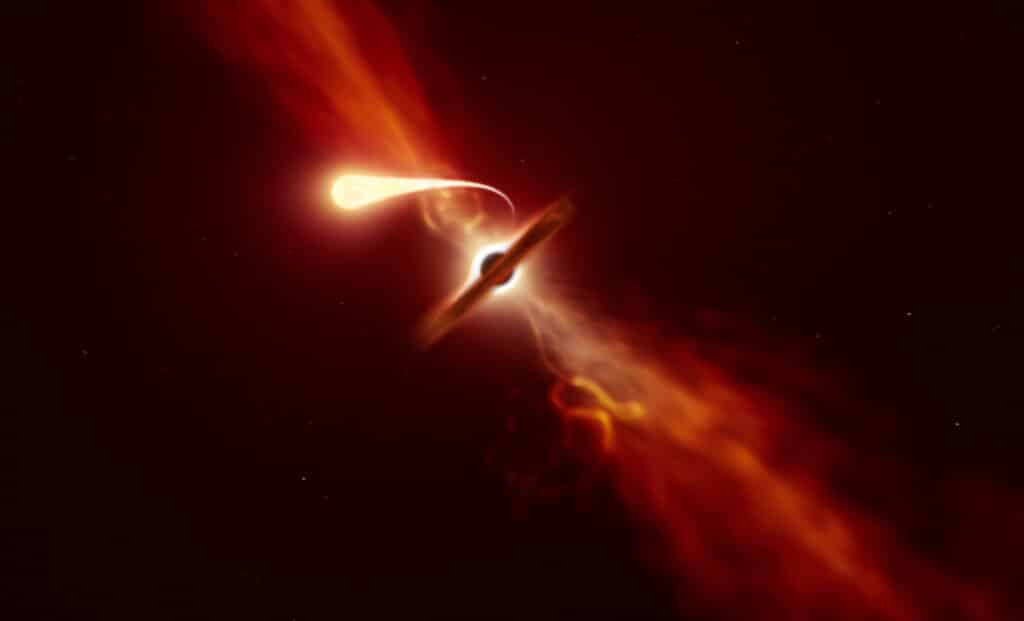A supermassive black hole has been captured ripping apart a star 8.5 billion light years from Earth. Astronomers say this phenomenon is the source of a mysterious bright flash researchers discovered in deep space, adding that the black hole’s “jet stream” is pointing right at our planet.
Huge amounts of debris travelling close to the speed of light were ejected into space as the distant sun got too close to the singularity. From our perspective, the beams, called “relativistic jets,” are pointing straight at Earth. It the furthest such incident ever seen.
The incredibly rare phenomenon is known as a tidal disruption event (TDE). In the Milky Way, they occur up to once every 100,000 years.
“The last time scientists discovered one of these jets was well over a decade ago,” says co-lead author Dr. Michael Coughlin from the University of Minnesota, according to a statement from SWNS.
“The beams are known as relativistic jets —beams of matter traveling close to the speed of light—after destroying a star,” Coughlin continues. “From the data we have, we can estimate relativistic jets are launched in only 1% of these destructive events, making AT2022cmc an extremely rare occurrence. In fact, the luminous flash from the event is among the brightest ever observed.”
An international team examined data collected in a survey called the Zwicky Transient Facility. It uses a camera attached to the Samuel Oschin Telescope at the Palomar Observatory in California.
“Our new search technique helps us to quickly identify rare cosmic events in the ZTF survey data,” says Dr. Igor Andreoni from the NASA Goddard Space Flight Center, according to SWNS. “And since ZTF and upcoming larger surveys such as Vera Rubin’s LSST scan the sky so frequently, we can now expect to uncover a wealth of rare, or previously undiscovered cosmic events and study them in detail.”
The burst of light is the result of the “spaghettification” of the star as gravity transformed it into a long, noodle-like string.

The discovery provides new insights into supermassive black holes and their effect on surrounding matter. The dead star became tightly wound — like spaghetti around a fork — to form a ball of hot plasma.
The black hole is millions or even billions of times the mass of our sun. Astronomers believe there is another supermassive black hole at the heart of the Milky Way galaxy.
The novel data-crunching method described in the journal Nature was equivalent to searching through a million pages of information every night. It allowed scientists to conduct a rapid analysis and identify the TDE with relativistic jets. Follow-up observations revealed an exceptionally bright event across the electromagnetic spectrum.
The black hole is at the center of a galaxy that is not yet visible because the light from the jet streams is even brighter at this time. Future observations with the Hubble or James Webb Space Telescopes may reveal the rest of the distant galaxy. Scientists believe a rapid black hole spin may be one necessary ingredient for jet launching.
The idea brings researchers closer to understanding the physics of supermassive black holes at the center of galaxies billions of light years away. Only a couple of possible jetted TDEs were known previously, primarily discovered by gamma-ray space missions.
They detect the highest-energy forms of radiation produced by these jets. With their new method, astronomers can now search for such rare events in ground-based optical surveys.
“Astronomy is changing rapidly. More optical and infrared all-sky surveys are now active or will soon come online,” Dr. Andreoni tells SWNS. “Scientists can use the TDE as a model for what to look for and find more disruptive events from distant black holes.”
“This means that more than ever, big data mining is an important tool to advance our knowledge of the universe.”
South West News Service writer Mark Waghorn contributed to this report.













